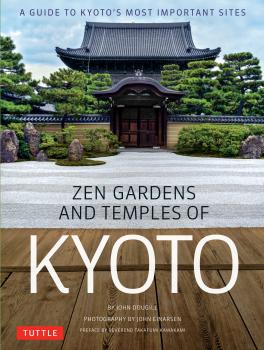ТОП просматриваемых книг сайта:
John Dougill
Список книг автора John DougillАннотация
This Japan travel guide presents a journey into the true heart of the Kyoto experience—one which brings you deep into the world of Kyoto's ancient Zen Buddhist culture. This is the first comprehensive guide to Kyoto's most important Zen garden and temple sites. Kyoto's Zen heritage represents one of mankind's greatest achievements—recognized by the large number which have been declared UNESCO World Heritage Sites. Millions of visitors travel to Kyoto yearly in search of their secrets, and here for the first time is a comprehensive overview of every major site. Over 50 Japanese temples and gardens—including all World Heritage Sites—are captured in sensitive photos by acclaimed Kyoto-based photographer John Einarsen. A detailed introduction to each temple by local expert John Dougill includes information about special opportunities for visitors to the temples—such as early morning meditation sessions, temple food offerings and special green tea sets provided to enhance the contemplative experience—along with other «insider» information that no other guide provides. The foreword by Takafumi Kawakami, the deputy head priest of the respected Shunkoin Temple in Kyoto, serves to place the book in the context of eastern and western Buddhist thought and practice. His widely viewed TED Talk «How mindfulness can help you to live in the present» has been viewed by over 100,000 people.
Аннотация
"It's a nice tome for armchair travel, whisking you off around the country from where you sit—or time travel, taking you back to that life-changing decade-lost holiday and old friends."— The Japan Times Visit the most compelling cultural and nature sites in all of Japan with this beautifully photographed travel guide.In Japan's World Heritage Sites , readers are introduced to the temples, gardens, castles and natural wonders for which Japan is so justly renowned—all of those now declared to be Unesco World Heritage Sites. Author John Dougill describes each site in detail, stating why they were singled out by Unesco, the current number and types of sites, the application process, how the sites have been selected, and how difficult it is to be given the special status of a World Heritage Site.Dougill traveled to all of the sites in Japan to research this book. Because the Japanese archipelago extends from Siberia all the way down to Taiwan, Dougill describes how his journey led him from the sub-Arctic to the sub-tropical zones. These are without a doubt the most interesting sites that Japan has to offer, including the following: Mount Fuji , Japan's tallest and most sacred volcano. Located on Honshu Island near Tokyo, Mt. Fuji is considered the sacred symbol of Japan Himeji Castle , a monument from Japan's long feudal history. Also known as Egret Castle, because it looks like a bird taking off in flight. Horyu-ji Temple , the world's oldest surviving wooden structure—a center of Buddhist learning that still serves as a seminary and monastery Hiroshima Peace Memorial or Atomic-Bomb Dome—one of the few structures to partially survive the atomic blast in 1945 The Ogasawara Islands , a remote archipelago of over 30 islands—including Iwo Jima—that is home to rare wildlife and spectacular scenery Readers will learn how Japan first became involved with the World Heritage Sites program back in 1993, the importance of these designations, and their popularity in Japan, where they are visited by millions of people annually, both Japanese and foreigners.


